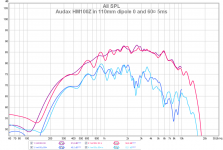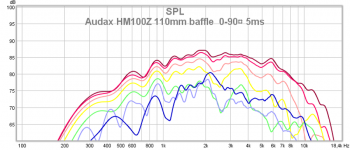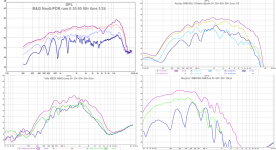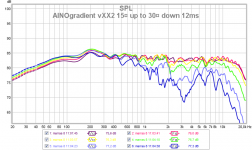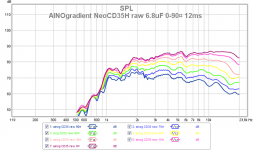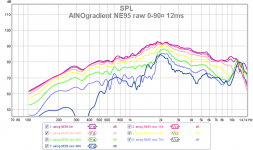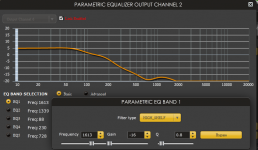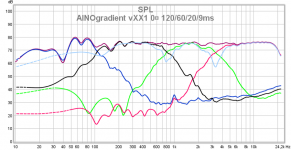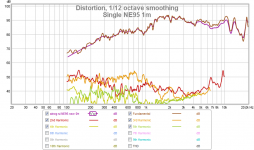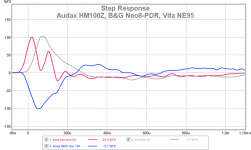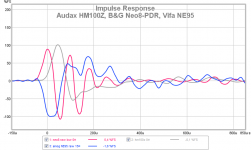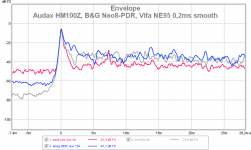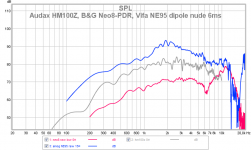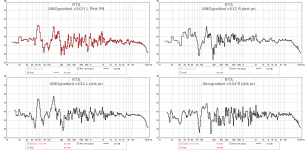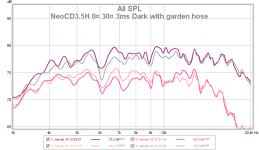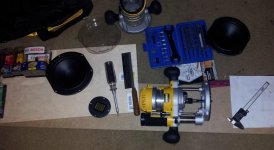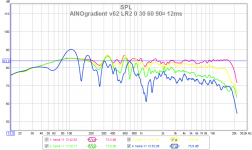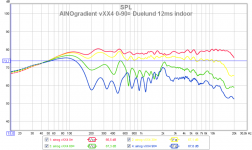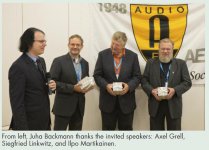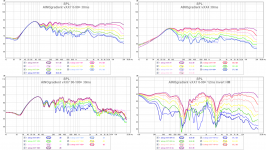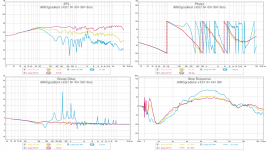Audax measurements redone with the wire connection turned downwards
Not a big difference to previous.
Notice that best dipole null shows at 60 and 75¤ and respectively at 105-120¤. 90¤ is always plaqued with raggedness. The cause of this is the cone profile of driver membrane and magnet structure. Planar Neo8 behaves just like simulation!
Audax doesn't have same kind of disturbation of directivity that NE95 shows at 2kHz. It should appear at around 1,5kHz with Audax's cone d=90mm. Perhaps the phase plug and coated paper cone make it radiate "softer " than the alu-cone NE95.
Not a big difference to previous.
Notice that best dipole null shows at 60 and 75¤ and respectively at 105-120¤. 90¤ is always plaqued with raggedness. The cause of this is the cone profile of driver membrane and magnet structure. Planar Neo8 behaves just like simulation!
Audax doesn't have same kind of disturbation of directivity that NE95 shows at 2kHz. It should appear at around 1,5kHz with Audax's cone d=90mm. Perhaps the phase plug and coated paper cone make it radiate "softer " than the alu-cone NE95.
Attachments
Last edited:
Comparison of horizontal directivity of Audax, Beyma, Vifa to B&G Neo8
Here we see 0¤ 30¤ 60¤ and 90¤ measurements of each driver as dipole, same scale. Neo8 and Audax are measured without xo. Vifa with AINO xo and eq indoor, Beyma with AINO xo and eq outdoors.
Notice the markedly better controlled behaviour of the planar driver in the passband 700-4000Hz. Beyma passband is 100-700Hz
Here we see 0¤ 30¤ 60¤ and 90¤ measurements of each driver as dipole, same scale. Neo8 and Audax are measured without xo. Vifa with AINO xo and eq indoor, Beyma with AINO xo and eq outdoors.
Notice the markedly better controlled behaviour of the planar driver in the passband 700-4000Hz. Beyma passband is 100-700Hz
Attachments
Last edited:
I had some quality time to do directivity measurements of individual drivers in AINOgradient, without eq and xo.
Measured with the speaker in the middle of the room mic at T height, 100cm distance. Pillows on the floor. 12ms gating. 1/12 smoothing except for LM
Horizontal 0-90¤ 15¤ increments.
Whole speaker also vertically 15¤ off-axis, 0 to -25¤ with 5¤ increments
W is omnidirectional, directivity not shown here. SEAS L26ROY sealed downfire
LM is dipole, nude Beyma 12"
HM is dipole, twin nude Vifa NE95 3"
T is monopole, nude Fountek NeoCD3.5H
Measured with the speaker in the middle of the room mic at T height, 100cm distance. Pillows on the floor. 12ms gating. 1/12 smoothing except for LM
Horizontal 0-90¤ 15¤ increments.
Whole speaker also vertically 15¤ off-axis, 0 to -25¤ with 5¤ increments
W is omnidirectional, directivity not shown here. SEAS L26ROY sealed downfire
LM is dipole, nude Beyma 12"
HM is dipole, twin nude Vifa NE95 3"
T is monopole, nude Fountek NeoCD3.5H
Attachments
I do use correction there! Despite the present LR4 xo at 800Hz it is needed! The dip/peak at dipole null becomes so sharp because the cone obviously has some resonance at the same frequency. Actually I use -16dB correction with Q=0.8 to dampen everything to match the falling curve of the tweeter! I sort of make double crossings for W/HM and LM/T - and I think that this is very important to make a good 3 or 4-way!.
Crossovers now at 110Hz, 800Hz 3300Hz
It is a battle to make eq and xo slopes working to make good phase match across crossovers. I can't even image how difficult it would be with passive xo's!
The worst problem is with NE95 loosing directivity at 2 -3kHz. Neo8 will solve that and also I get smoother vertical dispersion with it. Audax has that same problem just above 2kHz and it has dipole null too low too.
Crossovers now at 110Hz, 800Hz 3300Hz
It is a battle to make eq and xo slopes working to make good phase match across crossovers. I can't even image how difficult it would be with passive xo's!
The worst problem is with NE95 loosing directivity at 2 -3kHz. Neo8 will solve that and also I get smoother vertical dispersion with it. Audax has that same problem just above 2kHz and it has dipole null too low too.
Attachments
Last edited:
My crossover setup tries to follow the goals and principles of Steen Duelund's phase coherent 3-way crossovers (2nd order)
Jon Marsh uses this principle with his 3-way Isiris project
John Kreskowsky shows implementation of 4th order. The secret in these is that phase angles match and we see w and T crossing in the middle of M's passband.

Jon Marsh uses this principle with his 3-way Isiris project
John Kreskowsky shows implementation of 4th order. The secret in these is that phase angles match and we see w and T crossing in the middle of M's passband.

Beyma is just fine even crossed at 1kHz. But NE95 is really small driver and distortion becomes a problem if I cross it any lower. Being a dipole, it gets even worse with eq. Now it doesn't need eq below 1kHz
A single NE95 without eq and xo
A single NE95 without eq and xo
Attachments
More comparison of nude dipole Audax, B&G and Vifa
spl response, impulse, step response and ETC
B&G Neo8-PDR is "fastest" but shows ringing
I don't show distortion because measuremnts don't have equal spl, but when I compare several measurements Vifa is worst, Audax and B&G are close to each other
spl response, impulse, step response and ETC
B&G Neo8-PDR is "fastest" but shows ringing
I don't show distortion because measuremnts don't have equal spl, but when I compare several measurements Vifa is worst, Audax and B&G are close to each other
Attachments
Last edited:
Iam still waiting for the new baffle for Neo8. I took so RTA measurements to clear out bass response at listening area (2,2- 2,5m away)
First measurements of vXX2 show dips around 100Hz and 200Hz. Individual driver responses are very different in that area because their locations and radiation patterns are different. However summing is good. I changed "starting" slopes to LR2 and shifted xo form 100Hz to 130Hz. This helped and because of the management of response above xo W and upper mid sum well too.
RTA with pulsating pink noise, L and R speaker separately. Mic was moved around a little during the measurement. Notice that L and R room modes are different because my room is not symmetric. Room eq was not used! Speakers are tuned to have flat response at 15¤ off-axis.
First measurements of vXX2 show dips around 100Hz and 200Hz. Individual driver responses are very different in that area because their locations and radiation patterns are different. However summing is good. I changed "starting" slopes to LR2 and shifted xo form 100Hz to 130Hz. This helped and because of the management of response above xo W and upper mid sum well too.
RTA with pulsating pink noise, L and R speaker separately. Mic was moved around a little during the measurement. Notice that L and R room modes are different because my room is not symmetric. Room eq was not used! Speakers are tuned to have flat response at 15¤ off-axis.
Attachments
More comparison of nude dipole Audax, B&G and Vifa
spl response, impulse, step response and ETC
B&G Neo8-PDR is "fastest" but shows ringing
I don't show distortion because measuremnts don't have equal spl, but when I compare several measurements Vifa is worst, Audax and B&G are close to each other
That ringing will change (for the better) once you have the baffles.
I hope so. It was measured in same kind of test baffle as Audax, same material, same stand, same room, same distance.
I did a small experiment - added rouding to the edges of the Fountek NeoCD3.5H
For rounding I used 1" garden hose! I just cut two pieces and then cut them longitudinally and put on the sides of the "baffle. They made a quite flush continuity from the throat of the "minihorn"
But measurements show only minor changes in diffractions, nothing really helpful. I was hoping to reduce ripples above 10kHz.
Measured at 0¤ and 30¤ horizontal off-axis. Dark line is with the garden hose rounding. Gating 3ms, no smoothing. Measuring distance 80cm at mid-tweeter level.
An externally hosted image should be here but it was not working when we last tested it.
For rounding I used 1" garden hose! I just cut two pieces and then cut them longitudinally and put on the sides of the "baffle. They made a quite flush continuity from the throat of the "minihorn"
But measurements show only minor changes in diffractions, nothing really helpful. I was hoping to reduce ripples above 10kHz.
Measured at 0¤ and 30¤ horizontal off-axis. Dark line is with the garden hose rounding. Gating 3ms, no smoothing. Measuring distance 80cm at mid-tweeter level.
Attachments
Still waiting for new frames...
I adjusted response, 2db more bass and fine tuning LM driver's response at 10-300Hz (vXX42). Below 300Hz is very difficult to tune because of room reflections and modes messing around. Listening tests are needed too.
All and individual responses of vXX41, showing xos inverted and also summing of W to HM and ML to T (a.m. Duelund&Kreskowsky)
I adjusted response, 2db more bass and fine tuning LM driver's response at 10-300Hz (vXX42). Below 300Hz is very difficult to tune because of room reflections and modes messing around. Listening tests are needed too.
All and individual responses of vXX41, showing xos inverted and also summing of W to HM and ML to T (a.m. Duelund&Kreskowsky)
Attachments
ETA on those frames?
Impressive curves 😉
Here's where I'm at as of lastnight... Wasn't expecting to spend another $500+ on tools to get this done, but my builder had surgery a few months back and can't. He's a great guy, deadly accurate and fast. Would say too fast for me 😉
Impressive curves 😉
Here's where I'm at as of lastnight... Wasn't expecting to spend another $500+ on tools to get this done, but my builder had surgery a few months back and can't. He's a great guy, deadly accurate and fast. Would say too fast for me 😉
Attachments
Last edited:
ETA was not defined. It is a small company in Jyväskylä that makes shop stands etc. advertising material for eg. Apple Finland and abroad. They took this little job as an extra because of curiosity. This company could have done the job too Kuviopuu - Puun ja muovin kuviointia. - Kyltit - Puukirjaimet - Koristeleikkaukset - Puukirjaimia - Muovikirjaimia - Irtokirjaimia
At another forum there was discussion about multiway dipole's crossovers. I discovered huge phase match problems when I made wie-angle off-axis measurements. Then someone guided me to check (again) Kreskosky's article about Duelund crossovers Duelund and Beyond
Gradually I changed every xo to follow LR4 type suggested by Kreskosky, with deepening "legs" to make phase matching further beyond xo point. It really worked and as I have said earlier, I believe that this is the only right way to set multi-dipole crossovers.
Phase coherence beyond xo-points is not so important for monopoles, because the backwave is blocked. Then it can' make a mess of everything.
This thread has chronology. But here I show you my version v62 that had LR2 crossovers except High-mid to Tweeter versus vXX4 with LR4"Kreskowsky". Notice the similarty of on-axis and 30¤ off-axis measurments. The huge difference appears at 60¤ and 90¤ off-axis. It can easily seen already at 45¤ but that is not shown here. On-axis response, phase and step response do not reveal this! But distortion and CSD do, the problem is to understand what is causing it.
Think about a dipole speaker in a room. There is more reflected sound than from a monopole. And how does it sound when 60% of power response is constituted of sound with messed phase. It sounds diffuse I can say, not airy! v62 and vXX4 sound very different, anyone will hear that.
At another forum there was discussion about multiway dipole's crossovers. I discovered huge phase match problems when I made wie-angle off-axis measurements. Then someone guided me to check (again) Kreskosky's article about Duelund crossovers Duelund and Beyond
Gradually I changed every xo to follow LR4 type suggested by Kreskosky, with deepening "legs" to make phase matching further beyond xo point. It really worked and as I have said earlier, I believe that this is the only right way to set multi-dipole crossovers.
Phase coherence beyond xo-points is not so important for monopoles, because the backwave is blocked. Then it can' make a mess of everything.
This thread has chronology. But here I show you my version v62 that had LR2 crossovers except High-mid to Tweeter versus vXX4 with LR4"Kreskowsky". Notice the similarty of on-axis and 30¤ off-axis measurments. The huge difference appears at 60¤ and 90¤ off-axis. It can easily seen already at 45¤ but that is not shown here. On-axis response, phase and step response do not reveal this! But distortion and CSD do, the problem is to understand what is causing it.
Think about a dipole speaker in a room. There is more reflected sound than from a monopole. And how does it sound when 60% of power response is constituted of sound with messed phase. It sounds diffuse I can say, not airy! v62 and vXX4 sound very different, anyone will hear that.
Attachments
A writeup of the 51st AES Conference in Helsinki has been published
http://www.aes.org/tmpFiles/JAES/20131128/JAES_V61_10_PG790.pdf
p.s I am not that Juha!
http://www.aes.org/tmpFiles/JAES/20131128/JAES_V61_10_PG790.pdf
p.s I am not that Juha!
Attachments
Nice report, nice location, good topics ! Now I regret that I wasn't there 😡
Those guys should come to where I live more often ! 😀
Those guys should come to where I live more often ! 😀
I went a little backwards and changed lowest xo back to LR2. It gives smoother transition in directivity and better room response. With LR4 spl "energy" around 200Hz went too low.
vXX7 with LR2/LR4/LR8 crossovers
vXX4 with LR4/LR4/LR4 crossovers
I show here also backwards radiation of vXX7 and 0-90¤ with reversed polarity of HM driver. We can notice that phase coherence remains very well arond 3kHz but suffers around 800Hz. At the lower crossing drivers have more physical time misalignment.
vXX7 with LR2/LR4/LR8 crossovers
vXX4 with LR4/LR4/LR4 crossovers
I show here also backwards radiation of vXX7 and 0-90¤ with reversed polarity of HM driver. We can notice that phase coherence remains very well arond 3kHz but suffers around 800Hz. At the lower crossing drivers have more physical time misalignment.
Attachments
- Home
- Loudspeakers
- Multi-Way
- Aino gradient - a collaborative speaker project
